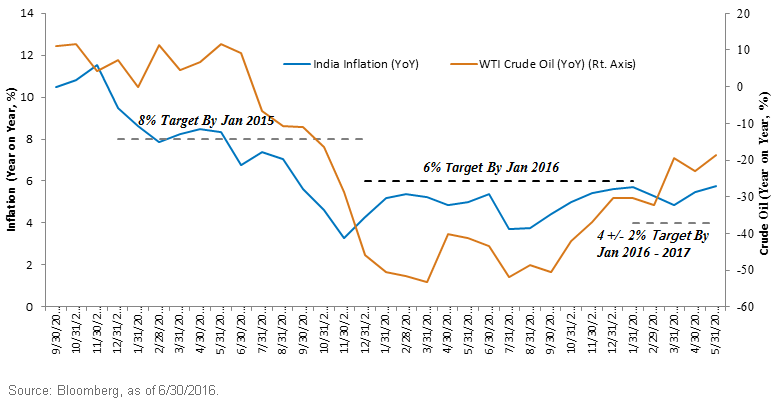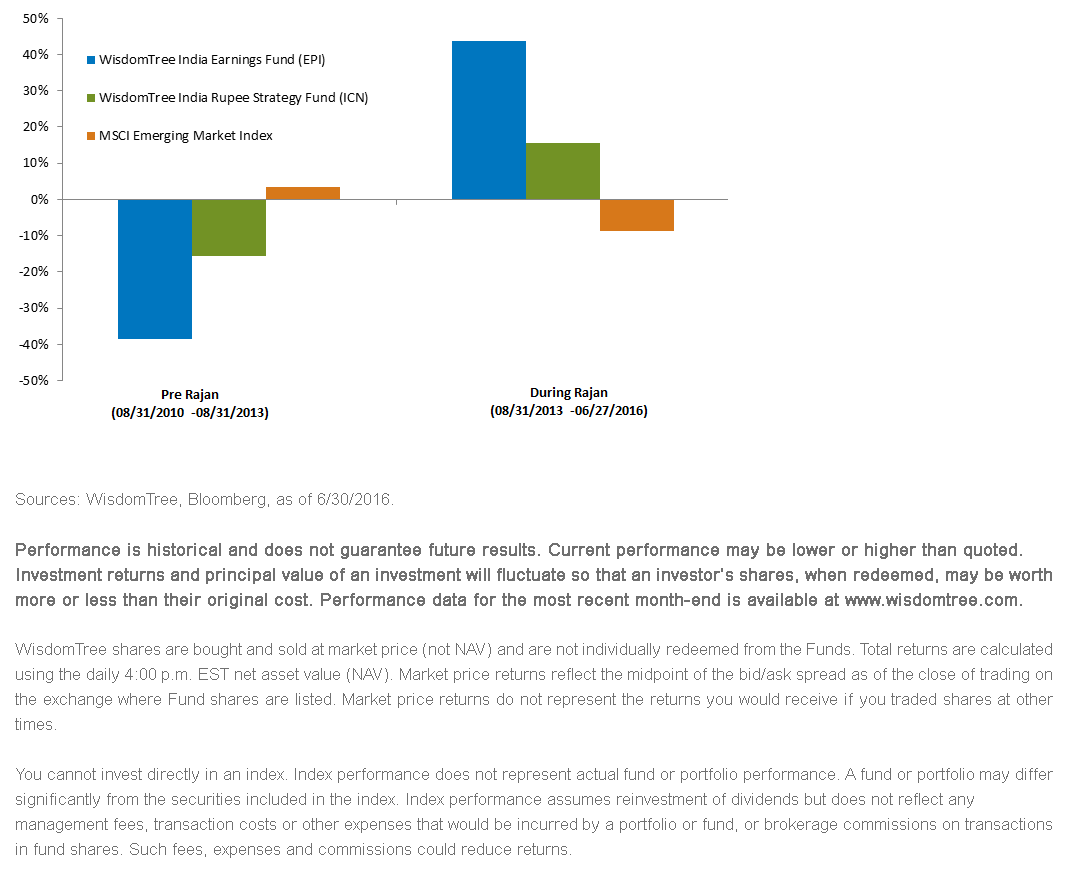Dr. Raghuram Rajan Exits: What’s Next for India


 India being the fourth largest importer of crude oil, it’s important to highlight here that reduction in inflation was not all because of declining global oil prices. India’s inflation already fell below 8% (from its peak of 11.5%) by July 2014, before the decline of oil prices. Oil prices were consistently going up by roughly 10% annually (right-hand axis). In January 2015, inflation was 400 basis points (bps) below the RBI’s target of 8%—a massive turnaround in 1.5 years, where inflation dropped from over 11% to below 5%. Assured by a speedy recovery of the economy, the astute governor kick-started the next round of his treatment by cutting rates, leading to 125 bps in consecutive cuts in 2015, with a new inflation target of 4% +/- 2%.4
Comparing Markets before and after Treatment by the Doctor
India also saw a significant improvement in its macro fundamentals. Current account and foreign reserves both built up significantly—a key reason for reduced volatility of the rupee and the gain in equities. While external circumstances were also beneficial to India, Dr. Rajan helped in compounding results and achieving what was previously unheard of. While credit risk in EM has been rising, India managed to navigate in the opposite direction. Lower FX volatility helped make the rupee one of the best carry-to-volatility trades in EM.
If there was one chart that could capture Dr. Rajan’s tenure, I believe it would be a performance comparison of the WisdomTree India Earnings (EPI) and Indian Rupee Strategy (ICN) Funds to EM (represented by the MSCI Emerging Markets Index) generally in periods before and during Dr. Rajan’s tenure. For standardized performance, visit the EPI and ICN pages.
India being the fourth largest importer of crude oil, it’s important to highlight here that reduction in inflation was not all because of declining global oil prices. India’s inflation already fell below 8% (from its peak of 11.5%) by July 2014, before the decline of oil prices. Oil prices were consistently going up by roughly 10% annually (right-hand axis). In January 2015, inflation was 400 basis points (bps) below the RBI’s target of 8%—a massive turnaround in 1.5 years, where inflation dropped from over 11% to below 5%. Assured by a speedy recovery of the economy, the astute governor kick-started the next round of his treatment by cutting rates, leading to 125 bps in consecutive cuts in 2015, with a new inflation target of 4% +/- 2%.4
Comparing Markets before and after Treatment by the Doctor
India also saw a significant improvement in its macro fundamentals. Current account and foreign reserves both built up significantly—a key reason for reduced volatility of the rupee and the gain in equities. While external circumstances were also beneficial to India, Dr. Rajan helped in compounding results and achieving what was previously unheard of. While credit risk in EM has been rising, India managed to navigate in the opposite direction. Lower FX volatility helped make the rupee one of the best carry-to-volatility trades in EM.
If there was one chart that could capture Dr. Rajan’s tenure, I believe it would be a performance comparison of the WisdomTree India Earnings (EPI) and Indian Rupee Strategy (ICN) Funds to EM (represented by the MSCI Emerging Markets Index) generally in periods before and during Dr. Rajan’s tenure. For standardized performance, visit the EPI and ICN pages.
 The three-year period preceding Dr. Rajan’s tenure marked an era of significant underperformance by both EPI and ICN, while results of his three-year tenure were completely opposite.
What’s Next; the Road Ahead for Investors
Dr. Rajan’s exit as governor of the RBI may dampen sentiments; however, his work of setting the right conditions for growth should have a lasting effect. Having dealt with many of the negatives associated with previous cycles (especially inflation), India is close to the trough of its expansion cycle. I believe lower inflation would allow for lower nominal rates and, along with that, a lower cost of capital over time. In fact, it is quite possible that Dr. Rajan decided to return to academic life only after he was satisfied with the longevity of current structures and the groundwork he had laid at the RBI.
I don’t expect any meaningful change in monetary policy going forward, as the government is equally interested in attracting capital flows, in my view. Continuing on its liberalization agenda, there has been a recent push for opening the defense, pharmaceutical and aviation sectors.
We expect Dr. Rajan’s replacement will be a capable economist who maintains the RBI’s goal of lowering inflation, clearing out stress from banking books and boosting domestic savings. The long-term macro trends, combined with the groundwork laid by Dr. Rajan that turned around the monetary and inflation outlook, are likely going to structurally make India an attractive investment destination for strategic investors, in my view.
Unless otherwise stated, data source is Bloomberg, as of 6/30/2016.
1Source: Bloomberg, as of 6/30/16.
2Source: Bloomberg, as of 6/30/16.
3Sources: Reserve Bank of India, Bloomberg, as of 6/30/16.
4Sources: Reserve Bank of India, Bloomberg, as of 6/30/16.
The three-year period preceding Dr. Rajan’s tenure marked an era of significant underperformance by both EPI and ICN, while results of his three-year tenure were completely opposite.
What’s Next; the Road Ahead for Investors
Dr. Rajan’s exit as governor of the RBI may dampen sentiments; however, his work of setting the right conditions for growth should have a lasting effect. Having dealt with many of the negatives associated with previous cycles (especially inflation), India is close to the trough of its expansion cycle. I believe lower inflation would allow for lower nominal rates and, along with that, a lower cost of capital over time. In fact, it is quite possible that Dr. Rajan decided to return to academic life only after he was satisfied with the longevity of current structures and the groundwork he had laid at the RBI.
I don’t expect any meaningful change in monetary policy going forward, as the government is equally interested in attracting capital flows, in my view. Continuing on its liberalization agenda, there has been a recent push for opening the defense, pharmaceutical and aviation sectors.
We expect Dr. Rajan’s replacement will be a capable economist who maintains the RBI’s goal of lowering inflation, clearing out stress from banking books and boosting domestic savings. The long-term macro trends, combined with the groundwork laid by Dr. Rajan that turned around the monetary and inflation outlook, are likely going to structurally make India an attractive investment destination for strategic investors, in my view.
Unless otherwise stated, data source is Bloomberg, as of 6/30/2016.
1Source: Bloomberg, as of 6/30/16.
2Source: Bloomberg, as of 6/30/16.
3Sources: Reserve Bank of India, Bloomberg, as of 6/30/16.
4Sources: Reserve Bank of India, Bloomberg, as of 6/30/16.Important Risks Related to this Article
There are risks associated with investing, including possible loss of principal. Foreign investing involves special risks, such as risk of loss from currency fluctuation or political or economic uncertainty. These Funds focus their investments in India, thereby increasing the impact of events and developments associated with the region, which can adversely affect performance. Investments in emerging, offshore or frontier markets such as India are generally less liquid and less efficient than investments in developed markets and are subject to additional risks, such as risks of adverse governmental regulation and intervention or political developments. As these Funds have a high concentration in some sectors, the Funds can be adversely affected by changes in those sectors.
Investments in currency involve additional special risks, such as credit risk and interest rate fluctuations. Derivative investments can be volatile, and these investments may be less liquid than other securities, and more sensitive to the effect of varied economic conditions. As these Funds can have a high concentration in some issuers, the Funds can be adversely impacted by changes affecting those issuers. Unlike typical exchange-traded funds, there are no indexes that the Funds attempt to track or replicate. Thus, the ability of the Funds to achieve their objectives will depend on the effectiveness of the portfolio manager. Due to the investment strategy of these Funds, they may make higher capital gain distributions than other ETFs. Please read each Fund’s prospectus for specific details regarding each Fund’s risk profile.


